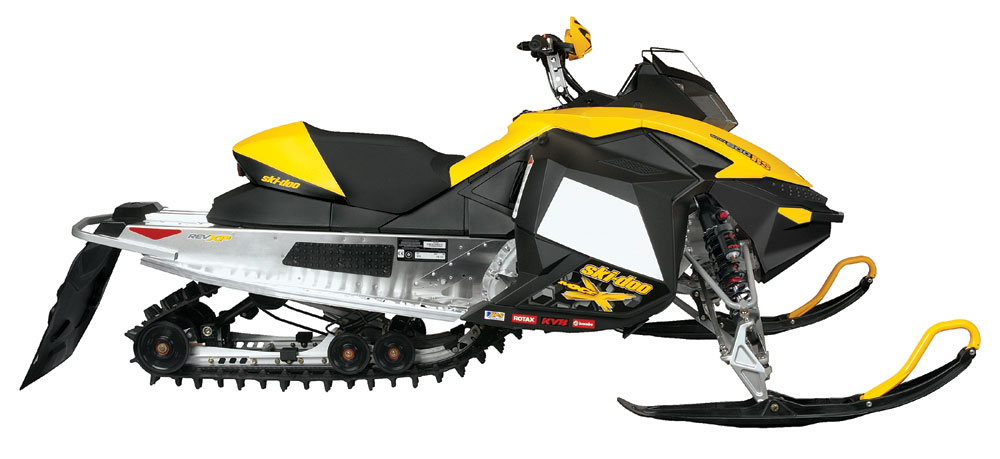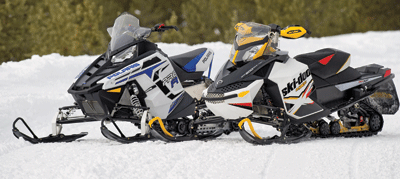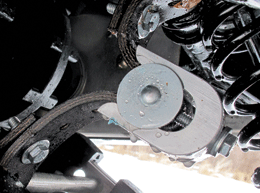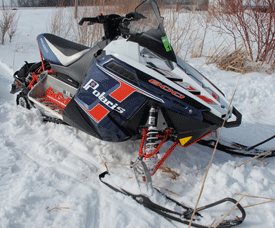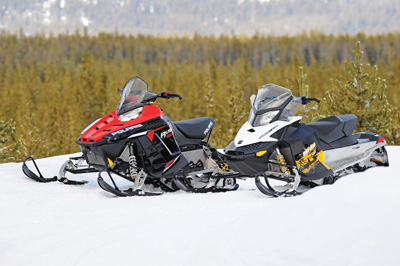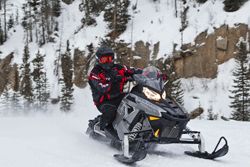2010 Polaris Rush challenges conventional snowmobile design
 Unless you’ve been asleep under a rock since spring, you know that Polaris has the biggest snowmobile news for 2010. Pardon the cliché above, but seriously, the 600 Rush’s outboard, progressive rear suspension is big news that might prove to be as significant as the 2003 Ski-Doo REV. Time will tell.
Unless you’ve been asleep under a rock since spring, you know that Polaris has the biggest snowmobile news for 2010. Pardon the cliché above, but seriously, the 600 Rush’s outboard, progressive rear suspension is big news that might prove to be as significant as the 2003 Ski-Doo REV. Time will tell.
The Pro Ride chassis that the new snowmobile is built upon is Polaris’ “platform for a lot of vehicles going forward,” said John Callahan, director of snowmobile engineering.
A peek under the hood shows quality is far above all other Polaris sleds, and a close examination proves that the Rush is built unlike anything that has come out of the company’s Roseau, Minnesota, plant. The chassis is intelligently laid-out and well engineered; every part and its function appears to have been scrutinized. Parts, panels and structures line up better than before, and the finish is cleaner. Serviceability appears to have been a priority during engineering rather than an afterthought.
On the trail, one of the Rush’s most redeeming traits is its handling. The front end stayed flat through turns requiring an acceptable amount of arm effort with good traction. The Pro Ride progressive rate rear suspension becomes more resistant to bottoming as the skidframe compresses into its travel, which is one of the most obvious traits when you ride this new sled.
In places where we’d normally cringe for fear of a harsh bottom-out at the low end of a big hole, the sled mowed over it with a smooth ‘clunk.’ Prototypes we rode must have been calibrated for this, because ride quality over trail chatter was no better than conventional skidframes. Perhaps that will change by production this fall.
Ergonomics of the Rush are an improvement over the IQ. It’s easy to transfer around the console and the handlebar didn’t get into our chest on tight, slow turns. We liked the 117 hp 600 CFI 2 engine, too. It has a strong pull like all other Liberty powerplants to go along with its high-performance sound.
The Polaris marketing crew brought a small fleet of machines to Rode Reports, sans short track IQs, Dragons and SwitchBacks. The Rush might seem like the company’s only sled this season because it is the focus of marketing efforts, but Polaris has a full line of sleds for 2010. As we reported last spring, most of the IQs get the updated bumper and console and the 600 CFI 2 replaces the CFI 4 engine. The LX badge returns in Polaris’ 136-inch solo-touring segment: 600 LX and Turbo LX.
Hits
+ Pro Ride chassis build quality
+ IQ console and bumper
+ Phantom/Cyclone brake
Misses
– Rush styled like two separate vehicles
– No storage in Rush
– Lineup missing a short-track cruiser
Intra-Brand Comparison: 800 Assault RMK vs. 800 RMK 155If you’re a Polaris rider who’s shopping for an 800-class mountain sled, you’re in luck because there are several choices under the 800 RMK nameplate. Here we examine the 800 Assault RMK and 800 RMK 155.
Both machines are built for deep snow, but they serve the needs of different riders with different tracks, shock packages and accessories.
What’s The Same?
Each of these mountain sleds is based on the IQ chassis and is built for deep snow and off-trail riding. The 800cc Liberty engine that moves them is good for about 145 hp.
Their front and rear suspensions are the same, except for shocks, number of bogey wheels and slight differences in travel. The sleds share Pro Taper handlebars and curved bar ends, but only the Dragon gets a center grab bar for side-hills and off-trail adventures.
What’s Different?
Differences lie in how these two mountain sleds are appointed. The Dragon RMK is equipped for what mountain riding is, in the traditional sense: bottomless powder and steep hillclimbs.
A 155-inch track with softer lugs make the Dragon performed well for light, fluffy snow. The Assault is designed for backcountry riding and has a 146-inch track with stiff lugs that are too aggressive for dry December-January mountain snow. Instead, this track is designed for spring riding when the snow is wet and set-up.
The Assault suspension is calibrated to tackle big bumps and hard landings with Walker Evans Needle front shocks where the Dragon has Walker Air dampers.
Behind The Bars
Both sleds rolled over well in deep snow and were easy to drive through technical sections. The sleds’ seats have a narrow profile that makes it easy for a driver to switch from one running board to the other. Power delivery was smooth, yet robust with enough grunt to pop up the front end if needed. Just squeeze the trigger and let the engine do the work to hop over a fallen tree or a blown-in creek bed.
If you want full-season, deep-snow mobility, buy the Dragon. It’s a mountain sled in the traditional sense with a track that works well in a wider range of conditions. It climbs like crazy and its fluid lines let it carve like a hot knife through butter. The sport’s best mountain suspension setup with premium shocks will prove capable for most aggressive mountain riders. Compared to the Assault, the only difference might show up when airing off of a big cornice.
Boondockers and flatland powder riders should go for the Assault. Its shorter track makes the sled easier to manipulate through confined areas with less push when going down the trail. While the harder lugs caused it to trench more in powder, it’s still a capable sled to get around in deep snow. The remedy, though, is simple as a quick track swap. Michigan U.P. boondockers and other flatland adventurers will find that the Assault works well on the trails that bring them to backcountry lakes and other secret hideaways. Both machines are suspended well for aggressive riders and big moguls, but the Assault worked better than the Dragon, and with the coil-over Walker Needle shocks up front, it will be even more capable to eat up the backcountry drifts (we tested the sled with compression-adjustable Walker Air shocks, which were originally slated for production).
Engineer Q&A: 600 Rush
Mike Bedard, 42
Engineering Manager, Trail Performance and Race
Mike Bedard has been with Polaris for 17 years, and he’s never been so excited about one of his company’s new snowmobiles. His engineering group’s biggest challenge to develop the 600 Rush was to not dismiss any concept too soon. Here is an excerpt of our interview with Bedard. For more inside information on making the Rush a reality, go to snowgoer.com.
Snow Goer: When you saw the idea for this external rear suspension for the first time, what did you think?
Mike Bedard: “I’ve been involved since the first sketch. My first reaction was, ‘Wow, that is really cool!’ The reaction of the team was, ‘We need to do this. This is going to be a game changer.’ It was radically different to the snowmobile world. The challenges [with conventional suspensions] were always the same; you have a regressive rate going on inside the wheel and you’re trying to come up with a progressive rate to deal with it. You could set a suspension up to work really well on small chatter and then you hit the big one. Geometry made us compromise. I think we [had] reached the top of that plateau and thought there’d be a better way. We all were [skeptical] a little bit. But that’s progress. If we always looked at things the same way we wouldn’t make progress.”
What’s the first thing a person will notice when he takes his new Rush for his first ride this winter?
“A lot of people are going to be really focused on the rear suspension. This thing does something different. Their confidence will grow to sit down and let the suspension work. This sleds corners really flat. They’re going to think, ‘It feels like my old Indy again.’ It really responds well to driver input. The more forward you are, it keeps the front down. Farther back gives you more traction. It’s more rider active.”
What do you think is this chassis’ greatest attribute?
“A number of things. This is the best handling Indy we’ve had in a long time. This one just feels so much sharper [than the IQ]. Adaptability and adjustability. You can really cater it to how you drive. This concept is so simple that I think people are going to get it. There are two very simple points [to remember]: the spring holds up the sled. With that you can adjust the balance. Bottom line is to adjust the spring to your rider weight. Then if you want more or less transfer, adjust it. Then stop. Bottoming is controlled by the shock.”
Based on your ride impressions, what type of rider stands to gain the most with this new sled?
“[There’s] been a misconception, that it looks like its only made for an aggressive rider. Every type of rider is going to appreciate this sled. A lot of test riders came back and said, ‘Don’t mis-market this sled.’ We can’t forget about the 90 percent of other people who [don’t] ride snowmobiles [aggressively]. We cover a wide range of riders with this snowmobile.”
Looking at the rear end of a Rush, it looks pretty complicated. Was development of the Pro-Ride suspension as complex and challenging as it seems it would have been?
“Yes (laughing). We’ve got some of the most talented people who know suspension better than anybody. Then they had to take everything they had learned [before] and put it aside … taking a step back and using all of their experience and know-how to figure out [during testing], ‘What is this thing really doing?’ The team opened their mind and came up with a pretty cool concept. It really forced us to think different about the way we develop the suspension. Not only from a seat-of-the-pants perspective, but data collection. We developed a lot of tools and high-end modeling, and using simulation tools to understand the reaction of the suspension. It didn’t react the same way previous suspensions reacted. The future holds great things for us and this project will lead to faster development of new vehicles.”
Are the loads against the rear shock a lot greater than in a conventional skidframe?
“Actually no. With a conventional rear skid you have coupling to deal with the huge spike load. We have eliminated that need by packaging [the suspension] outside of the wheel. With the Pro Ride, you can ramp up through the geometry rather than the shock. You don’t depend on the shock to control that massive bottom-out event. It lets the shocks be on the softer side for a better ride and use the geometry of the suspension to handle the big hit.”
Obviously, and rightfully so, the rear suspension configuration has grabbed all the headlines so far, but talk about another component or design of the Rush that deserves attention.
“The handling of this vehicle is fantastic. People think, ‘Oh yeah, it’s a big bump sled and that is all it does.’ It feels small, it feels light and it is easy to drive. We did a ton of work to make it 60 percent stiffer than our IQ. The footwells, cast bulkhead, over-structure and engine mount were all things to give it its rigid feel. Ride and handling are precise. You can just feel the difference in how it reacts.”
The chassis uses fewer welds and rivets than the IQ. How were you able to maintain strength and rigidity within the chassis?
“Use of structural bonding allowed us to join to dis-similar materials for the best overall design. That could be sheet aluminum, a casting [joined] to tubing, tubing to forging, etc. Structural bonding is very consistent. You don’t have to deal with weld distortions; every vehicle is the same. Every airplane you ride in, over-the-road trucks and a lot of automobile applications use structural bonding.”
Guys on the engineering team last winter said this is the future of Polaris snowmobiles. Where does Polaris go next with the Pro Ride chassis?
“I can’t say a lot. Stay tuned because this is only the beginning. It has a lot of potential. We’ve changed the game.”
ADD’L WEB CONTENT
Polaris Engineering Manager Mike Bedard had so much to say about the 600 Rush that we couldn’t fit it all in our season premier issue of Snow Goer. Here is the interview in its entirety

